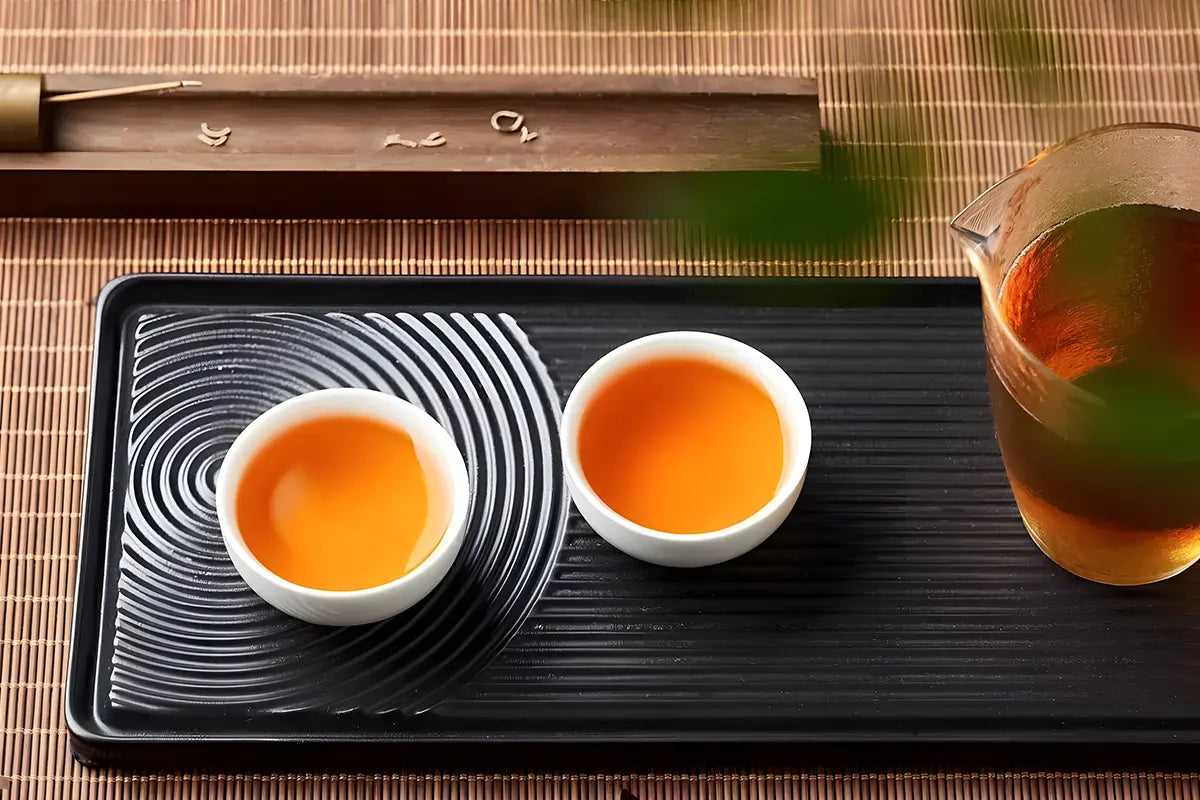Те, кто пробовал Да Хун Пао, были очарованы его уникальным Яньюнем — особым сортом, присущим только Да Хун Пао, производимому в горах Уи.
Проявление и ощущение Яньюня в Да Хун Пао можно описать как особенно мягкий вкус. Люди говорят, что у него «ощущение кости в воде». После питья быстро возвращается сладость, долгое послевкусие и отчетливая горловая рифма. Аромат, независимо от его интенсивности, остается стойким и глубоким, с заметным ароматом даже в холодном состоянии. Чайные листья выдерживают многократные заваривания, обычно 7-10 или более. Качество стабильное (чайные листья устойчивы к хранению).
Итак, как же образовался этот уникальный Яньюнь? Давайте рассмотрим ниже.
Ключевые факторы, влияющие на Яньюнь Да Хун Пао
1 Уникальная экологическая среда гор Уишань
Горы Уи, в широком смысле относящиеся к горному хребту Уи и в узком смысле к живописной местности горы Уи, также охватывают административную юрисдикцию города горы Уи. Живописная местность горы Уи изначально была сформирована из осадочных пород морского дна, позже поднятых горным хребтом Уи, в отличие от гранитной местности. Песчаник легко разрушается светом, дождем, ветром и другими факторами, образуя грубые и отличительные черты, которые мы видим сегодня на протяжении миллионов лет. Рельеф Данься характеризуется обрушением и выветриванием слоев красного песчаника.
Почва из красного песчаника находится между «гнилой скалой» и «гравийной почвой» и является зрелой почвой с рыхлой текстурой, хорошей проницаемостью и благоприятными условиями для поглощения чайными деревьями питательных веществ. Лу Юй, ученый из династии Тан, описал ее в «Классике чая»: «Чай, лучший растет на гнилой скале, средний на гравийной почве и самый низкий на желтой почве». Это высококачественное состояние почвы является необходимым требованием для производства одного из лучших листовых чаев , Да Хун Пао.
«Гнилая скала» и «гравийная почва» — это зрелые почвы, подходящие для выращивания чая. В горах Уи рельеф Данься в основном сосредоточен в живописном районе горы Уи и расходится в окружающие районы. Таким образом, чайные горы в Тридцати шести вершинах и Девяносто девяти скалах горы Уи являются известными районами производства чая Уи Янь, где производят высококачественные скальные чаи, такие как «Чжэнъянь» и «Минъянь», а «Три ямы и два ручья» особенно известны.
«Три ямы и два ручья» относятся к пяти конкретным местам: «Яма Нюлань», «Яма Даошуй», «Яма Хуэйюань», «Ручей Люсян» и «Ручей Уюань». Для любителей чая, которые ценят чай из утеса Уи, упоминание «Трех ям и двух ручьев» похоже на знакомую мелодию, и каждый считает удачей возможность пить чай из утеса Уи из этих мест.
Высокие горы дают хороший чай, а равнины могут похвастаться красивыми цветами. В живописном районе горы Уи, где пересекаются овраги, много солнечного света, туманы окутывают окрестности и высокая относительная влажность, почва в основном состоит из красного песчаника с рыхлой и проницаемой текстурой. В сочетании с хорошо функционирующим водным циклом, благоприятная биологическая цепь сформировалась среди различных видов. Величие горы Уи заключается в ее превосходных природных условиях, с уровнем лесного покрова 80%, особенно в выращивании чая. Благодаря таким обильным природным преимуществам, производимый листовой чай почти весь высокого качества, побуждая древних людей восхищаться и объявлять чай из скалы Уи «даром небес».
2 метода выращивания чая Уишань
Уникальный рельеф горы Уи, характеризующийся ограниченным количеством почвы на склонах, побудил местных фермеров разработать сложный метод выращивания чая, известный как «Техника каменного сиденья», также называемый «Метод посадки вогнутых камней». При этом методе фермеры строят каменные насыпи вдоль горных впадин, скальных углублений и расщелин. Они заполняют эти сооружения почвой и высаживают семена чая, создавая «горшечный» чайный сад, похожий на выращивание бонсай.
Два выдающихся метода в рамках «методов выращивания чая Уи» — это «метод глубокой вспашки» и «метод гостевой почвы». Во время процесса глубокой вспашки в августе и сентябре эффективные питательные вещества около корня поднимаются к поверхности. Это позволяет корням извлекать пользу из воздействия солнечного света, борьбы с насекомыми и болезнями, а также созревания почвы. Гостевая почва, богатая такими микроэлементами, как Fe, Cu, Mg, Zn, Mo, Cl, имеет решающее значение для придания чаю уникальных характеристик Яньюнь.
В масштабах страны этот метод выращивания чая характерен для горы Уи и редко встречается в других регионах, где выращивается чай. Из-за трудоемкости этого метода он не применяется повсеместно, если только экономическая ценность чая не достаточно высока.
Факторы, влияющие на Яньюнь Да Хун Пао
1 Возраст дерева
За годы обработки свежих листьев, собранных в таких местах, как «Три ямки и два ручья», было замечено, что молодые чайные деревья, особенно сорта Водяной нарцисс, легко производят аромат, но не имеют отчетливого Яньюня. Чайные деревья с более коротким возрастом действительно проявляют Яньюнь, в то время как чаи, изготовленные из деревьев в возрасте 20 лет и более, не только имеют сильный аромат, но и очень заметный Яньюнь.
2. Созревание свежих листьев во время сбора урожая
Внешний слой крупных, открытых свежих листьев имеет более толстые клеточные стенки, а слой кутикулы полностью дифференцирован. Воск снаружи кутикулы содержит жирные кислоты с высоким содержанием углерода и мононенасыщенные жирные кислоты с высоким содержанием углерода, что способствует аромату чая улун. Более зрелые свежие листья содержат более высокие уровни каротина, крахмала, сахара и эфирных экстрактов, что способствует образованию «Яньюнь» в листовом чае улун .
3 метода обработки чая

Уникальные методы обработки чая Wuyi Rock включают в себя особый процесс зеленого производства, известный как «два солнечных и два воздушных», сочетающий тяжелые и легкие методы. Этот процесс включает наблюдение и внесение корректировок на этапе зеленого производства, с основным акцентом на двойную обжарку, двойное скручивание, удаление зелени для усиления аромата и формование чая в полоски. Первичная выпечка, повторная выпечка и созревание аромата способствуют как цвету, так и вкусу, что делает их важнейшими факторами в формировании «Яньюнь».
Если вы хотите ощутить классический вкус Да Хун Пао, не стесняйтесь посетить iTeaworld для выбора и покупки. В дополнение к Да Хун Пао, iTeaworld предлагает множество классических китайских чаев в форме пробников чая , что позволит вам легко ощутить лучшие и самые аутентичные вкусы китайского чая.
Подводя итог, Яньюнь относится к аромату и вкусу чая улун, который происходит из превосходных сортов, выращенных в рельефе Данься горы Уи, обработанных с использованием традиционных методов выращивания и производства чая Wuyi Rock. Надеюсь, эта статья поможет вам лучше понять Яньюнь из Да Хун Пао.














































































